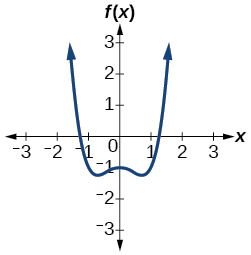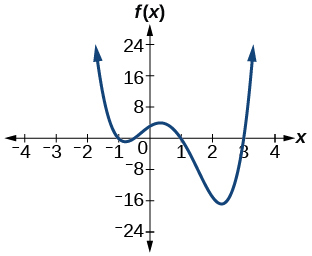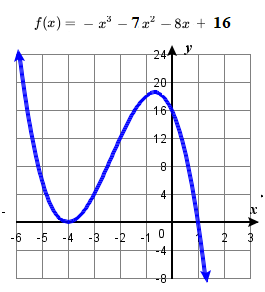3.6e: Exercises - Zeroes of Polynomial Functions
( \newcommand{\kernel}{\mathrm{null}\,}\)
A: Concepts
Exercise 3.6e.A: Concepts
1) Describe a use for the Remainder Theorem.
2) Explain why the Rational Zero Theorem does not guarantee finding zeros of a polynomial function.
3) What is the difference between rational and real zeros?
4) If Descartes’ Rule of Signs reveals a 0 or 1 change of signs, what specific conclusion can be drawn?
5) If synthetic division reveals a zero, why should we try that value again as a possible solution?
- Answers to odd exercises:
-
1. The theorem can be used to evaluate a polynomial.
3. Rational zeros can be expressed as fractions whereas real zeros include irrational numbers.
5. Polynomials can have repeated zeros, so the fact that number is a zero doesn’t preclude it being a zero again.
B: Use the Remainder Theorem to Evaluate a Polynomial
Exercise 3.6e.B: Use the Remainder Theorem
★ Use synthetic division to evaluate p(c) and write p(x) in the form p(x)=(x−c)q(x)+r.
|
6. p(x)=2x2−x+1, c=4 7. p(x)=4x2−33x−180, c=12 8. p(x)=2x3−x+6, c=−3 9. p(x)=x3+2x2+3x+4, c=−1 10. p(x)=3x3−6x2+4x−8, c=2 |
11. p(x)=8x3+12x2+6x+1, c=−12 12. p(x)=2x4+x3−4x2+10x−7, c=32 13. p(x)=x4−3x3−20x2−24x−8, c=7 14. p(x)=x4−5x2−8x−12, c=3 15. p(x)=x4−5x3+x2+5, c=2 |
- Answers to odd exercises:
-
7. p(12)=0, p(x)=(x−12)(4x+15)
9. p(−1)=2, p(x)=(x+1)(x2+x+2)+2
11. p(−12)=0, p(x)=(2x+1)(4x2+4x+1)
13. p(7)=216, p(x)=(x−7)(x3+4x2+8x+32)+216
15. p(2)=−15, p(x)=(x−2)(x3−3x2−5x−10)−15
C: Given one zero or factor, find all Real Zeros, and factor a polynomial
Exercise 3.6e.C: Use the Factor Theorem given one zero or factor
★ Given a polynomial and one of its factors, find the rest of the real zeros and write the polynomial as a product of linear and irreducible quadratic factors.
|
17) f(x)=2x3+x2−5x+2; Factor: (x+2) 18) f(x)=3x3+x2−20x+12; Factor: (x+3) 19) f(x)=2x3+3x2+x+6; Factor: (x+2) 20) f(x)=−5x3+16x2−9; Factor: (x−3) |
21) f(x)=x3+3x2+4x+12; Factor: (x+3) 22) f(x)=4x3−7x+3; Factor: (x−1) 23) f(x)=2x3+5x2−12x−30; Factor: (2x+5) 24) f(x)=2x3−9x2+13x−6; Factor: (x−1) |
- Answers to odd exercises:
-
17. −2,1,12; f(x)=(x+2)(x−1)(2x−1)
19. −2; f(x)=(x+2)(2x2−x+3)
21. −3; f(x)=(x+3)(x2+4)
23. −52,√6,−√6; f(x)=(2x+5)(x−√6)(x+√6)
★ Given a polynomial and c, one of its zeros, find the rest of the real zeros and write the polynomial as a product of linear and irreducible quadratic factors. It is possible some factors are repeated.
|
25. p(x)=x3−24x2+192x−512,c=8 26. p(x)=3x3+4x2−x−2,c=23 27. p(x)=2x3−3x2−11x+6,c=12 28. p(x)=x3+2x2−3x−6,c=−2 29. p(x)=2x3−x2−10x+5,c=12 |
30. p(x)=4x4−28x3+61x2−42x+9,c=12 31. p(x)=x5+2x4−12x3−38x2−37x−12, c=−1 32. p(x)=2x5+7x4−18x2−8x+8, c=12 33. p(x)=3x5+2x4−15x3−10x2+12x+8, c=−23 |
- Answers to odd exercises:
-
25. zeros: 8; p(x)=(x−8)3
27. zeros: 12,−2,3; p(x)=(2x−1)(x+2)(x−3)
29. zeros: 12,±√5; p(x)=(2x−1)(x+√5)(x−√5)
31. zeros: −1, −3, 4; p(x)=(x+1)3(x+3)(x−4)
33. zeros: −2,−1,−23,1,2;
p(x)=(x+2)(x+1)(x−1)(x−2)(3x+2)
D: List all Possible Rational Zeros
Exercise 3.6e.D: Use the Rational Zero Theorem
★ Use the Rational Zeros Theorem to list all possible rational zeros for each given function.
|
35) f(x)=2x3+3x2−8x+5 36) f(x)=3x3+5x2−5x+4 37) f(x)=6x4−10x2+13x+1 38) f(x)=4x5−10x4+8x3+x2−8 |
39. f(x)=x3−2x2−5x+6 40. f(x)=x4+2x3−12x2−40x−32 41. f(x)=x3−7x2+x−7 42. f(x)=x3+4x2−11x+6 43. f(x)=x4−9x2−4x+12 |
44. f(x)=−2x3+19x2−49x+20 45. f(x)=−17x3+5x2+34x−10 46. f(x)=36x4−12x3−11x2+2x+1 47. f(x)=3x3+3x2−11x−10 48. f(x)=2x4+x3−7x2−3x+3 |
- Answers to odd exercises:
-
35. ±5,±1,±12,±52
37. ±1,±12,±13,±16
39. ±1, ±2, ±3, ±6 41. ±1, ±7
43. ±1, ±2, ±3, ±4, ±6, ±12
45. ±1, ±2, ±5, ±10, ±117,±217,±517,±1017
47. ±1, ±2, ±5, ±10, ±13,±23,±53,±103
E: Find all Zeros that are Rational
Exercise 3.6e.E: Find all zeros that are rational
★ Use the Rational Zero Theorem to find all real number zeros.
|
49) x3−3x2−10x+24=0 50) 2x3+7x2−10x−24=0 51) x3+2x2−9x−18=0 52) x3+5x2−16x−80=0 53) x3−3x2−25x+75=0 |
54) 2x3−3x2−32x−15=0 55) 2x3+x2−7x−6=0 56) 2x3−3x2−x+1=0 57) 3x3−x2−11x−6=0 58) x4−2x3−7x2+8x+12=0 |
59) 4x3−3x+1=0 60) 4x4+4x3−25x2−x+6=0 61) x4+2x3−9x2−2x+8=0 62) x4+2x3−4x2−10x−5=0 63) −5x4+4x3−19x2+16x+4=0 |
- Answers to odd exercises:
-
49. −3,2,4 51. −2,3,−3
53. 3,−5,5 55. 2,−1,−32
57. −23,1±√132 59. −1,12
61. 1,2,−1,−4 63. −15,1
★ Find the real zeros of the polynomial. State the multiplicity of each real zero.
|
65. f(x)=x3−2x2−5x+6 66. f(x)=x3+4x2−11x+6 |
67. f(x)=x4−9x2−4x+12 68. f(x)=−17x3+5x2+34x−10 69. f(x)=36x4−12x3−11x2+2x+1 |
70. f(x)=2x4+x3−7x2−3x+3 71. f(x)=2x3+7x2+4x−4 72. f(x)=−2x4−3x3+10x2+12x−8 |
- Answers to odd exercises:
-
65. x=1 (mult. 1), x=3 (mult. 1), x=−2 (mult. 1)
67. x=−2 (mult. 2), x=1 (mult. 1), x=3 (mult. 1)
69. x=12 (mult. 2), x=−13 (mult. 2)
71. x=−2 (mult. 2), x=12 (mult. 1)
F: Find all zeros (both real and imaginary)
Exercise 3.6e.F: Find all zeros
★ Use the Rational Zero Theorem to find all complex solutions (real and non-real).
|
72.5) x3+x2+x+1=0 73) x3−8x2+25x−26=0 |
74) x3+13x2+57x+85=0 75) 3x3−4x2+11x+10=0 |
76) x4+2x3+22x2+50x−75=0 77) 2x3−3x2+32x+17=0 |
- Answers to odd exercises:
-
73. 2,3+2i,3−2i 75. −23,1+2i,1−2i 77. −12,1+4i,1−4i
G: Find all zeros and sketch
Exercise 3.6e.G: Find all zeros and sketch
★ Determine the end behaviour, all the real zeros, their multiplicity, and y-intercept. Sketch the function. (Use synthetic division to find a rational zero. Use the quotient to find the next zero).
|
78) f(x)=x3−1 79) f(x)=x4−x2−1 80) f(x)=x3−2x2−5x+6 81) f(x)=2x3+37x2+200x+300 82) f(x)=x4+2x3−12x2+14x−5 |
83) f(x)=2x4−5x3−5x2+5x+3 84) f(x)=x3−2x2−16x+32 85) f(x)=−x3−7x2−8x+16 86. f(x)=−x4−4x3+3x2+10x−8 |
87. f(x)=x4−6x3+8x2+6x−9 88. f(x)=x4+4x3−5x2−36x−36 89. f(x)=x5−x4−5x3+x2+8x+4 90. f(x)=x4+2x3+6x−9 |
- Answers to odd exercises:
-
79. zeros (odd multiplicity): ±√1+√52, 2 imaginary zeros, y-intercept (0,1)

81. zeros (odd multiplicity): {−10,−6,−52}; y-intercept: (0,300)
.jpg?revision=1)
83. zeros (odd multiplicity); {−1,1,3,−12}, y-intercept (0,3).

85. zeros; −4 (multiplicity 2), 1 (multiplicity 1), y-intercept (0,16).

87. odd multiplicity zeros: {1,−1}; even multiplicity zero: {3}; y-intercept (0,−9).

89. odd multiplicity zero: {−1}, even multiplicity zero {2}. y-intercept (0,4).

H: Given zeros, construct a polynomial function
Exercise 3.6e.H: Given zeros, construct a polynomial function
★ Construct a polynomial function of least degree possible using the given information. You may leave the polynomial in factored form.
91) A lowest degree polynomial with real coefficients and zero 3i
92) A lowest degree polynomial with rational coefficients and zeros: 2 and √6
93) A lowest degree polynomial with integer coefficients and Real roots: –1 (with multiplicity 2), and 1.
94) A lowest degree polynomial with integer coefficients and Real roots: –2, and 12 (with multiplicity 2)
95) A lowest degree polynomial with integer coefficients and Real roots:−12,0,12
96) A lowest degree polynomial with integer coefficients and Real roots: –4,–1,1,4
97) A lowest degree polynomial with integer coefficients and Real roots: –1,1,3
98. A lowest degree polynomial with real coefficients and zeros: −2 and −5i
99. A lowest degree polynomial with real coefficients and zeros: 4 and 2i.
100. The solutions to p(x)=0 are x=±3 and x=6. The leading term of p(x) is 7x4.
The point (−3,0) is a local minimum on the graph of y=p(x).
101. The solutions to p(x)=0 are x=±3, x=−2, and x=4, The leading term of p(x) is −x5.
The point (−2,0) is a local maximum on the graph of y=p(x).
102. p is degree 4. as x→∞, p(x)→−∞ p has exactly three x-intercepts: (−6,0), (1,0) and (117,0).
The graph of y=p(x) crosses through the x-axis at (1,0).
103. Find a quadratic polynomial with integer coefficients which has x=35±√295 as its real zeros.
- Answers to odd exercises:
-
91. f(x)=(x2+9)
93. f(x)=(x+1)2(x−1)
95. f(x)=x(2x+1)(2x−1)
97. f(x)=(x+1)(x−1)(x−3)
99. p(x)=(x−4)(x−2i)(x+2i)=x3−4x2+4x−16
101. p(x)=−(x+2)2(x−3)(x+3)(x−4)
103. p(x)=5x2−6x−4
I: Use Intermediate Value Theorem
Exercise 3.6e.I: Intermediate Value Theorem
★ Use the Intermediate Value Theorem to confirm the polynomial f has at least one zero within the given interval.
|
104) f(x)=x3−9x, between x=−4 and x=−2. 105) f(x)=x3−9x, between x=2 and x=4. 106) f(x)=x5−2x, between x=1 and x=2. |
107) f(x)=−x4+4, between x=1 and x=3. 108) f(x)=−2x3−x, between x=–1 and x=1. 109) f(x)=x3−100x+2, between x=0.01 and x=0.1 |
- Answers to odd exercises:
-
105. f(2)=–10,f(4)=28.
Sign change confirms.107. f(1)=3,f(3)=–77.
Sign change confirms.109. f(0.01)=1.000001,f(0.1)=–7.999.
Sign change confirms.
x

